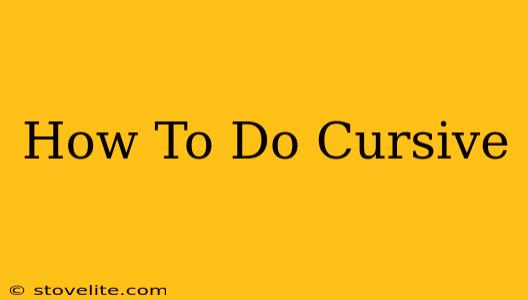Cursive handwriting, also known as script, is a beautiful and efficient way to write. While it might seem daunting at first, mastering cursive is achievable with practice and the right approach. This comprehensive guide will walk you through the process, covering everything from essential tools to advanced techniques. Let's dive in and learn how to do cursive!
Getting Started: Essential Materials
Before you begin your cursive journey, gather the necessary supplies. The right tools can significantly impact your learning experience and the quality of your handwriting.
- Paper: Use lined paper specifically designed for cursive practice. The lines provide a visual guide for letter height and spacing.
- Pen: Choose a pen with a comfortable grip and smooth ink flow. Avoid pens that are too thick or too thin. Ballpoint pens are a good starting point, but felt-tip pens can also be helpful for beginners. Experiment to find what feels best for you.
- Pencil (Optional): Using a pencil for initial practice allows for easy corrections and revisions. Once you feel confident, transition to a pen.
Mastering the Basics: Essential Cursive Strokes
Cursive writing is built upon a series of fundamental strokes. Practicing these strokes will build the muscle memory needed for fluid and elegant writing.
1. The Oval: The Foundation of Cursive
The oval is the cornerstone of many cursive letters. Practice making smooth, consistent ovals, both clockwise and counter-clockwise. Focus on maintaining consistent size and shape.
2. The Upstroke and Downstroke: Creating Curves and Angles
Mastering the smooth transitions between upstrokes and downstrokes is crucial for connecting letters seamlessly. Practice connecting ovals and other shapes with flowing lines.
3. Connecting Letters: The Key to Fluency
The beauty of cursive lies in its connected nature. Practice connecting basic letters like "a," "o," and "i" to create simple words. Focus on the smooth transitions between each letter.
Learning the Alphabet: From A to Z
Now it's time to tackle the alphabet. There are many cursive alphabets available; choose a style you find appealing and consistent. Many resources offer free printable cursive alphabet charts which can be a great starting point.
- Start Slowly: Don't rush! Focus on accuracy over speed. Practice each letter individually, paying close attention to the specific strokes and connections.
- Break Down Complex Letters: Some letters, such as "z" and "g," can be more challenging. Break these letters down into smaller, manageable components.
- Practice Regularly: Consistency is key. Dedicate a few minutes each day to cursive practice. Even short, regular practice sessions will yield better results than infrequent, long sessions.
Improving Your Cursive: Tips and Techniques
Once you've mastered the alphabet, continue practicing to improve your speed, legibility, and overall style.
- Focus on Consistency: Aim for consistent letter size, spacing, and slant.
- Practice with Sentences and Paragraphs: Gradually increase the complexity of your practice by writing sentences and then paragraphs.
- Find a Cursive Writing Partner: Practicing with a friend or family member can be motivating and provide feedback.
- Utilize Online Resources: Numerous websites and apps offer cursive writing practice exercises and tutorials.
- Don't Be Afraid to Experiment: Once you're comfortable, experiment with different styles and techniques to find your unique cursive voice.
Conclusion: Embrace the Elegance of Cursive
Mastering cursive takes time and dedication, but the rewards are well worth the effort. With consistent practice and a positive attitude, you'll be writing elegant, flowing cursive in no time! Remember, practice makes perfect. So grab your pen, paper, and start your cursive journey today!

